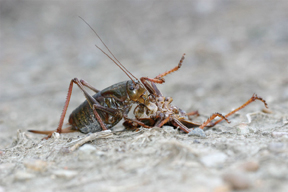What drives the relentless march of Mormon crickets across the landscape is both a craving for food and a reluctance to be cannibalized, says an international research team.

The swarms loom large in the lore of the American West, but scientists hadn’t worked out the dynamics of what keeps the insects on the move, says Stephen Simpson of the University of Sydney in Australia. He and his colleagues now report that swarming Mormon crickets are deficient in protein and salt. They march over the countryside in quest of the missing nutrients, but the laggards provide excellent dining for their fellow crickets. Simpson and his colleagues propose in the March 14 Proceedings of the National Academy of Sciences that hunger and danger combine to keep Mormon crickets rolling.
“It’s terrific to see this work because so little is known about them,” says entomologist Darryl Gwynne of the University of Toronto at Mississauga in Ontario.
Mormon crickets generally live mild-mannered lives, foraging at low densities. Sometimes, though, they form a cricket parade several million strong and up to 10 kilometers long. Although these insects can’t fly, the crowd can walk and hop 2 km a day.
Simpson describes a rustling sound as the Mormon crickets swarm forward. “They will crawl over you and nip you too,” he says. “There is a horror movie in there for sure.”
Simpson and his colleagues suspected that the crowd pushes on when what’s left to eat in the current spot doesn’t meet their nutritional needs.
The researchers offered swarms in the field various dry insect chows. Insects jostled each other fiercely for the highest-protein choices. High-carbohydrate chows didn’t generate enthusiasm.
In another test, swarming crickets crowded around cotton wool soaked in a moderately salty solution in preference to cotton soaked in plain water.
But in the lab experiments, crickets permitted to gorge on their choice of food shifted to a lower-protein, less-salty diet after a day or two.
One of the better ways to replenish proteins and salt is to eat another Mormon cricket, Simpson says. Even a swarming cricket contains more protein and salt than many plants do. Simpson and his colleagues found that crickets that didn’t move as fast as others or that had died tended to be eaten by their more mobile compatriots.
“It’s the first time cannibalism has been shown as a force in animal group movements,” says Simpson.
What drives these swarms had been an old, unanswered question, says Anthony Joern of Kansas State University in Manhattan. “I was really excited by the paper,” he says, “because I didn’t expect there would ever be an answer.”






